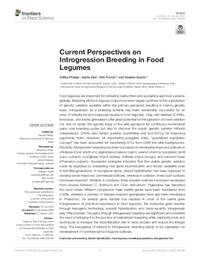Current Perspectives on Introgression Breeding in Food Legumes

Authors:
Food legumes are important for defeating malnutrition and sustaining agri-food systems globally. Breeding efforts in legume crops have been largely confined to the exploitation of genetic variation available within the primary genepool, resulting in narrow genetic base. Introgression as a breeding scheme has been remarkably successful for an array of inheritance and molecular studies in food legumes. Crop wild relatives (CWRs), landraces, and exotic germplasm offer great potential for introgression of novel variation not only to widen the genetic base of the elite genepool for continuous incremental gains over breeding cycles but also to discover the cryptic genetic variation hitherto unexpressed. CWRs also harbor positive quantitative trait loci (QTLs) for improving agronomic traits. However, for transferring polygenic traits, “specialized population concept” has been advocated for transferring QTLs from CWR into elite backgrounds. Recently, introgression breeding has been successful in developing improved cultivars in chickpea (Cicer arietinum), pigeonpea (Cajanus cajan), peanut (Arachis hypogaea), lentil (Lens culinaris), mungbean (Vigna radiata), urdbean (Vigna mungo), and common bean (Phaseolus vulgaris). Successful examples indicated that the usable genetic variation could be exploited by unleashing new gene recombination and hidden variability even in late filial generations. In mungbean alone, distant hybridization has been deployed to develop seven improved commercial cultivars, whereas in urdbean, three such cultivars have been reported. Similarly, in chickpea, three superior cultivars have been developed from crosses between C. arietinum and Cicer reticulatum. Pigeonpea has benefited the most where different cytoplasmic male sterility genes have been transferred from CWRs, whereas a number of disease-resistant germplasm have also been developed in Phaseolus. As vertical gene transfer has resulted in most of the useful gene introgressions of practical importance in food legumes, the horizontal gene transfer through transgenic technology, somatic hybridization, and, more recently, intragenesis also offer promise. The gains through introgression breeding are significant and underline the need of bringing it in the purview of mainstream breeding while deploying tools and techniques to increase the recombination rate in wide crosses and reduce the linkage drag. The resurgence of interest in introgression breeding needs to be capitalized for development of commercial food legume cultivars.
